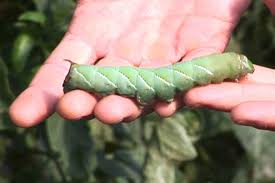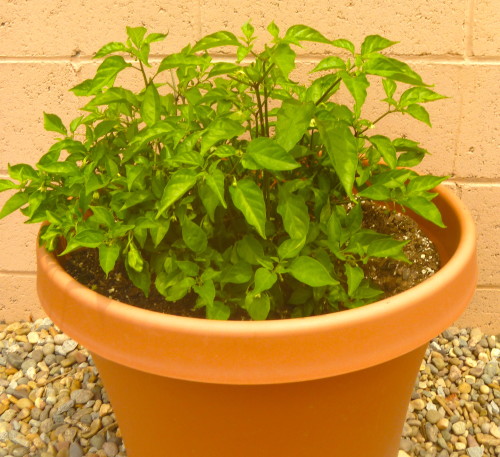By Dave DeWitt
The summer is a great time to grow chile pepper plants—except when it’s not. Over my decades of growing chile peppers I have had to overcome many threats to the plants but fortunately, all of these problems did not happen in the same year. But it could happen, so I’m going to warn you in advance about the worst threats to your chile garden so that you can be like a Boy Scout: prepared.
Disease Control with Physical Barriers

Leafhopper
My worst disease problem has been with curly top virus, which is one hundred percent fatal to both chiles and tomatoes. It is spread by the beet leaf hopper, which lives primarily in spring weeds like London rocket. Even entomologists can’t predict if or when these insects will migrate into your garden, so the first thing to do is remove all spring weeds from your yard.
The second thing you can do is a physical barrier like cheesecloth or other netting so that the leafhoppers can’t touch your plants and spread the virus. This is not easy to do because the larger the plants the more netting you will need, and high winds are a constant problem to keep the netting in place. Leafhopper season can run from May to July, so your only other solution is to do nothing but buy new plants to replace the ones that die. As soon as you see the symptoms—a lack of growth and the curling and yellowing of top leaves—remove the plants from your garden and dispose of them in plastic garbage bags. Do not compost them.
Water Evenly with One Exception
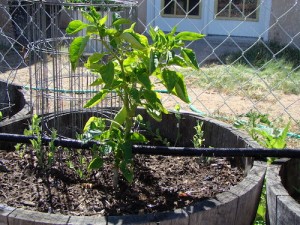 Irregular watering can result in a condition of your pepper pods known blossom end rot. The symptom is the tip of the pod (the blossom end rather than the stem end) rotting and then falling off. So try to water on a regular basis with the same amount of water each time. This can be accomplished by using soaker hoses beneath garden fabric. Set the water pressure by adjusting the spigot to the same position each time, and allow the water to drip for the same amount of time for each watering.
Irregular watering can result in a condition of your pepper pods known blossom end rot. The symptom is the tip of the pod (the blossom end rather than the stem end) rotting and then falling off. So try to water on a regular basis with the same amount of water each time. This can be accomplished by using soaker hoses beneath garden fabric. Set the water pressure by adjusting the spigot to the same position each time, and allow the water to drip for the same amount of time for each watering.
The only time you may want to vary this is when you are deliberately stressing the pods to make them hotter by withholding water until the plants wilt a little. Only do this during the last few weeks before the harvest and you will reduce the chances of getting blossom end rot.
But always be careful when watering. Make sure that the garden is well-drained and that water does not stand in the garden. Standing water will trigger the growth of fungal spores of phytophthora, which causes root rot that can kill every plant in your garden, not just chile plants.
High Heat and Sun Scald
Remember, it’s the chile plants’ leaves that need full sun, not the pods. In fact, sometimes large-podded chile plants don’t produce enough foliage to protect the pods from the ultraviolet rays which can burn the pods and create a condition called sun scald that can partially ruin them for eating. The answer is artificial shading with window screens or shade cloth. Again, wind is the biggest problem when shading the garden. But shading can also help prevent water loss by transpiration during the hottest days of the summer, which means you can use less water in the garden.
Counterattack the Pests
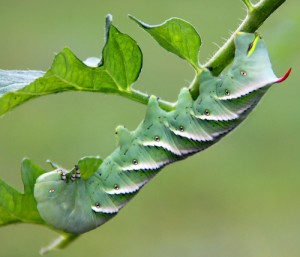
A tomato hornworm
The two worst insect pests of chile peppers besides the leafhoppers mentioned earlier are tomato hornworms and grasshoppers. Tomato hornworms are large caterpillars of the five-spotted hawk moth and can reach nearly four inches long. You’d think they’d bee easy to spot on the plants, but they are not because they hide upside down among the foliage. They are harmless to humans and the best way to control them is to keep an eye out for foliage damage and inspect the plants closely. Physically pull the hornworms off the plants (wear gloves if you’re an insect wimp) and throw them on gravel, concrete, or asphalt where birds can find them easily. Robins love to eat them, as do roadrunners and grackles.
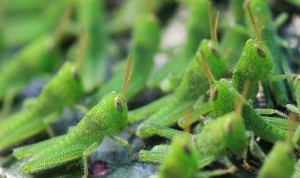
Grasshoppers
Grasshopper infestations of chile plants can be devastating as they can eat their own weight in foliage every day—or so it seems. You can hunt them with a fly-swatter and stun them by knocking them to the ground and then step on them. If you’re a trout or bass fisherperson, don’t step on them but keep them in jars with air holes in the lids and they make great live baits. The other solution is organic grasshopper bait such as Semaspore or Nolo, which is spread around the plants. The grasshoppers eat the bait, which contains Nosema locustae, a naturally occurring single-celled protozoan that infects all stages of developing grasshoppers, mole crickets, Mormon and black field crickets. Nosema when ingested creates a disease that is specific to these pests. It will not harm any other living species. The grasshoppers become sick, eat less, and begin to die.
The biggest mistake most chile gardeners make is failing to inspect their gardens every day. If you do examine your garden carefully every day, you can catch most of the problems before they become fatal to you chile plants.








